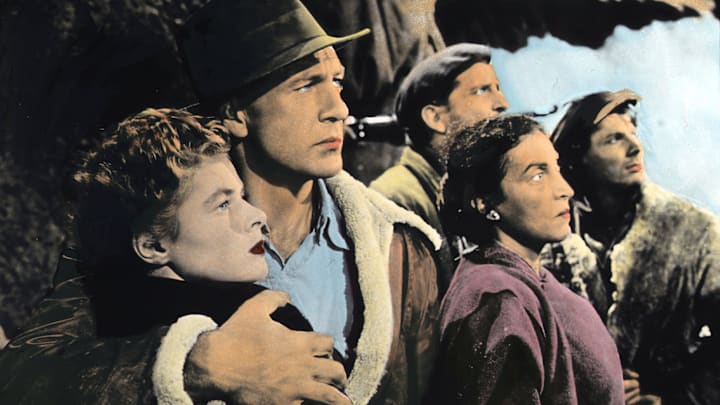Ernest Hemingway wasn’t a huge fan of cinema. According to his son Patrick, “pictures on the silver screen were nothing but pure illusion (…) and not to be taken seriously.”
His relationship with the screen, which over the course of his lifetime developed from a technological curiosity into a cultural force, was undoubtedly shaped by his identity as a writer—as an artist who expressed himself not in images but in words, and by the time of his death saw his age-old trade swept aside by a new, different medium.
While the author himself would probably have begged to differ, the following five films are considered some of the best Hemingway adaptations out there.
- A Farewell to Arms (1932)
- For Whom the Bell Tolls (1943)
- The Killers (1964)
- The Old Man and the Sea (1958)
- Captain Khorsid (1987)
A Farewell to Arms (1932)
Originally published in 1929 and based on his experience serving as an American ambulance driver during the First World War, A Farewell to Arms follows a wounded lieutenant who falls in love with the nurse who nurses him back to health, culminating in the couple’s ill-fated attempt to leave the war behind.
This adaptation, directed by Frank Borzage and starring Gary Cooper and Helen Hayes in the two leading roles, was nominated for four Academy Awards and ended winning two: one for Best Cinematography, and another for Best Sound. Made before the existence of codes, the film was—for a time—banned on account of its portrayal of sexuality and violence.
For Whom the Bell Tolls (1943)
Like A Farewell to Arms, this novel was released only a few years before its big screen adaptation, in 1940. Also steeped in personal experience, it follows an American volunteer fighting against fascist forces during the Spanish Civil War. This soldier, too, falls in love, forcing him to choose between duty and happiness.
Directed by Sam Wood, this adaptation was nominated for Best Picture. Gary Cooper returns to play the leading role, this time starring alongside Ingrid Bergman—seen for the first time in Technicolor. Aside from faithfully adapting the story, it sticks close to its themes of pacifism and the futility of war.
The Killers (1964)
Unlike most of the other entries on this list, this film isn’t based on a novel or novella but a short story. First seen in 1927 in Scribner’s Magazine and later republished alongside other stories as part of the Men Without Women collection, it tells the story of two hitmen who set out to kill a former boxer—a premise revisited by Quentin Tarantino in Pulp Fiction.
This film, directed by Don Siegel, is actually the story’s second big-screen adaptation. The only adaptation Hemingway somewhat liked (thanks in no small part to Gardner), it stars U.S. President Ronald Reagan in one of his last acting roles before he began focusing exclusively on his political career.
You May Also Like:
Add Mental Floss as a preferred news source!
The Old Man and the Sea (1958)
Arguably Hemingway’s best-known literary work, ultimately earning him the Nobel Prize in Literature, The Old Man and the Sea follows an elderly Cuban fisherman who spends 84 days out at sea trying to catch a giant marlin, only to see the object of his obsession devoured by sharks.
Brought to the big screen by John Sturges, this adaptation stars Spencer Tracy as the fisherman (named Santiago) and Felipe Pazos as Manolin, the young boy whom he refuses to bring along onto the water. Winning an Academy Award for Best Score, the film preserves and effectively communicates its source material’s musings on courage, perseverance, and loneliness.
Captain Khorsid (1987)
The only entry on this list produced outside of Hollywood, as well as the only one to bear a different name, Captain Khorsid is loosely based on Hemingway’s 1937 novel To Have and Have Not, about a cash-strapped boat captain forced to take up illegal smuggling during the Great Depression.
Filmed in Iran and directed by Nasser Taghvai, this adaptation transplants the story from Cuba to the Persian Gulf and reimagines the captain as a one-handed sailor transporting wanted criminals. Captain Khorsid is not just one of the best Hemingway adaptations; it’s also widely considered one of the best Iranian movies ever.
Hemingway’s gripes with cinema were deeply personal for other reasons, too, including the fact that he famously disliked most Hollywood adaptations of his work. He once told Ava Gardner, who played Lady Brett Ashley in an adaptation of The Sun Also Rises, that one of the only things he liked about the film was her.
A stickler for realism, Hemingway was happy to learn that a TV version of The Killers cast an actual Swedish boxer in the role in the role of a Swedish boxer, and saddened to hear that The Old Man and the Sea would not be directed by Vittorio De Sica—known for Bicycle Thieves—nor star nonprofessional actors.
Whether he liked it or not, though, Hemingway was one of the most frequently adapted writers of the 20th century—a feat attributable to his popularity as much as his curt, direct, no frills writing style, not unlike the language style of screenplays.
